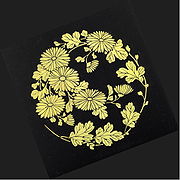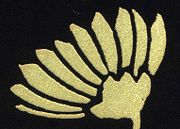
Maki-e
Encyclopedia


Japanese lacquerware
Japanese lacquerware is a broad category of fine and decorative arts, as lacquer has been used in paintings, prints, and on a wide variety of objects from Buddha statues to bento boxes for food.A number of terms are used in Japanese to refer to lacquerware...
sprinkled with gold or silver powder as a decoration using a makizutsu or a kebo brush. The technique was developed mainly in the Heian Period
Heian period
The is the last division of classical Japanese history, running from 794 to 1185. The period is named after the capital city of Heian-kyō, or modern Kyōto. It is the period in Japanese history when Buddhism, Taoism and other Chinese influences were at their height...
(794–1185) and blossomed in the Edo Period
Edo period
The , or , is a division of Japanese history which was ruled by the shoguns of the Tokugawa family, running from 1603 to 1868. The political entity of this period was the Tokugawa shogunate....
(1603–1868). Maki-e objects were initially designed as household items for court nobles, they soon gained more popularity and were adopted by royal families and military leaders as an indication of power.
To create different colours and textures, maki-e artists use a variety of metal powders including gold, silver, copper, brass, lead, aluminum, platinum, pewter, as well as their alloys. Bamboo tubes and soft brushes of various sizes are used for laying powders and drawing fine lines. As it requires highly-skilled craftsmanship to produce a maki-e painting, young artists usually go through many years of training to develop the skills and to ultimately become maki-e masters. Kouami Douchou (1410–1478) was the first lacquer master linked to specific works. His maki-e works used designs from various Japanese contemporary painters. Kouami and another maki-e master, Igarashi Shinsai, were originators of the two major schools of lacquer-making in the history of Japan.
Takamakie (or "raised maki-e") is one of the three major techniques in maki-e making. Developed in the Muromachi Period
Muromachi period
The is a division of Japanese history running from approximately 1336 to 1573. The period marks the governance of the Muromachi or Ashikaga shogunate, which was officially established in 1338 by the first Muromachi shogun, Ashikaga Takauji, two years after the brief Kemmu restoration of imperial...
(1336–1573), the technique of takamakie involves building up design patterns above the surface through a mixture of metal powder, lacquer and charcoal or clay dust.
Another special kind of maki-e is togidashi maki-e, where a black lacquer without oil is put on the metal decoration as an additional coat.

